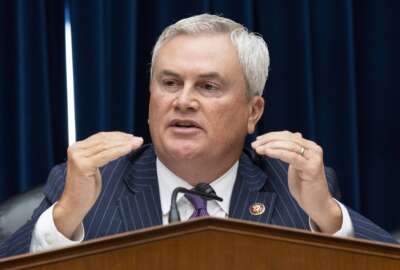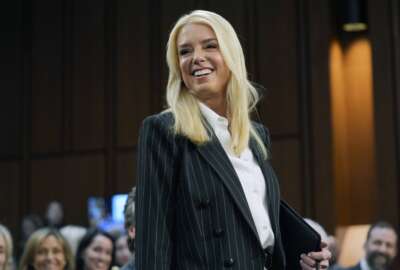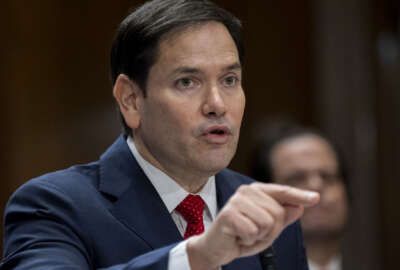A new push by the Energy Department to beef up the electric battery workforce
"Argonne has been DOE's trusted partner in building and executing workforce development programs for 35 years," Kristen Wahl said.
The Biden administration and automobile industry’s push towards electric vehicles isn’t going to go very far without the workers to make those batteries. In an effort to ensure a solid pipeline of talent there, the Battery Workforce Challenge Program is a new initiative from the Energy Department, looking to fill those jobs. It aims to build and train the next batch of battery and electric vehicle (EV) technicians, electricians, skilled workers, and engineers. To discuss more, Director of Energy Justice & Workforce Readiness for the Advanced Energy Technologies Directorate within the Energy Department, Kristen Wahl, joined the Federal Drive with Tom Temin.
Interview transcript:
Kristen Wahl Very excited to announce our latest workforce initiative at Argonne National Laboratory called the Battery Workforce Challenge Program. So, Battery Workforce Challenge is a comprehensive workforce development program really designed to build and train a diverse domestic workforce to promote job creation across the battery and the supply chain. So that means technicians, electricians, skilled workers and, of course, engineers and scientists. The program features four different initiatives, including what we announced last week, which was a nationwide network of regional workforce training hubs. And these hubs are really intended to kind of step into the critical skills gaps and identify areas to kind of reskill and upskill vocational and transitional workers for those in-demand IB and battery manufacturing jobs. That’s a little bit about the program.
Eric White So, yeah, who’s going to be making up most of these, the actual cohorts or the consortiums that are going to be involved in this? And also trying to, you know, training, and I know that a lot of universities are probably going to have a hand in this, but we could also get to the industry side as well.
Kristen Wahl Yeah. So I’ll just kind of start off with a little bit of background about all the different partners. And primarily our role at Argonne National Laboratory. So Argonne has been DOE’s trusted partner in building and executing workforce development programs for 35 years. It started back in 1988, where Argonne helped DOD launch the Advanced Vehicle Technology competitions or AVTCs. And I’ve personally been involved as a leader of that program for about 27 years at Argonne. So strong role in leading and developing these workforce programs for the Department of Energy. But this this latest program is is a new initiative that includes about a $30 million investment between the Department of Energy and our industrial partners. So a strong public private partnership and consortium, as you mentioned, of of partners to build a STEM ecosystem, if you will, around these regional battery manufacturing areas across the nation. So these ecosystems are essentially a collaboration of universities, community colleges, vocational and secondary schools, key community partners, you know, government organizations. We mentioned industry already, but labor organizations, which is central to the design and execution of this, and of course, nonprofit organizations who are heavily involved in workforce development. So Argonne has a key role in convening all these partners together and in helping to deliver the mission and in really creating these these Stem kind of talent pipelines into these new battery manufacturing and EV assembly facilities that are being stood up across the country as a result of the Inflation Reduction Act and the bipartisan infrastructure law, which of course are are just, you know, once in a generation levels of investments in battery and heavy manufacturing here in the U.S. to really on for those jobs and and build up that supply chain across the country.
Eric White It seems as if every STEM field never has enough new talent coming through, but what is the current state of the need for talent in the battery and EV sectors?
Kristen Wahl Yeah, it’s such a good point that this has always been a challenge and that’s why we’ve been so invested in this for more than three decades, right? So historically, our focus has been on kind of building that stem pipeline of engineers and scientists for the automotive industry. But our footprint has really expanded. We’re talking today, of course, about battery and heavy manufacturing. But we’re really naming into other areas of clean energy, which as you mentioned, there are such a strong demand for talent really across the whole portfolio, but kind of driving some of these investments, which I think is really getting at the heart of your question. There have been a number of sort of government and industry reports and needs assessments, if you will, that help to inform our investments and workforce development. There’s a recent report from the we the 2024 U.S. Energy and Employment Report, which showed that clean energy jobs grew by 4.2% and 2023, adding 142,000 new jobs. But but the work is still needed to really further develop out that STEM pipeline. And so we have actually funded a study from the Center for Automotive Research to do a needs assessment specifically for battery and manufacturing. And this report is called the BIETN Report, which is by Aetna. And this report really kind of looks at all of the different jobs that are needed kind of end to end in the battery and supply chain. So meaning upstream, midstream and downstream. What are the real demands in the industry and what are the best practices for how to deliver the specific kind of skills that are needed to kind of fill in those critical gaps? And there’s that in our report, which, by the way, stands for Battery Industry Education and Training Needs. It has has really helped to kind of inform and shape the Battery Workforce Challenge program, how we’re investing in in Stem and career technical education at the high school level and then also at vocational and transitional workers for reskilling and upskilling those electricians and skilled trades. And then also, as I mentioned before, engineers and scientists. So really all across that education pipeline to really kind of fill in those critical skills gaps.
Eric White Acknowledging that this is a workforce initiative. I’m just curious and I wanted to pick your brain on, you know, it takes a lot of technical materials and supplies to actually create these electric vehicles or EVs and batteries. Which side do you see the greater need? Is there a greater need for workers or a greater need for a steady supply of everything that is needed that goes into creating the actual devices themselves?
Kristen Wahl Yeah, and that’s exactly where this needs assessment helps to again inform our investments because it actually goes into some of the the gaps in the supply chain on the upstream side. So where are your mining resources? You’re creating that supply chain for the individual components and for the workers to build those components and have a domestic supply chain for those. And then all the way through that, the production of the battery components and then not only the components, but also building the modules and then the parts for the components and then the assembly and integration into the EV itself and then the recycling and in supply so that the whole end to end circular economy of the supply chain is and there are gaps in all areas of that. As I recall from the needs assessment, some of the biggest areas of shortest supply, if you will, are in sort of the electrochemistry battery management system kind of product and system design portion of that. But there are there are really needs across all segments of the supply chain.
Eric White Kristen Wahl is director of energy, justice and workforce readiness for the Advanced Energy Technologies Directorate at the Department of Energy. You can find this interview along with a link to more information at federalnewsnetwork.com. Listen to the Federal Drive on your schedule. Subscribe wherever you get your podcasts.
Copyright © 2025 Federal News Network. All rights reserved. This website is not intended for users located within the European Economic Area.
Tom Temin is host of the Federal Drive and has been providing insight on federal technology and management issues for more than 30 years.
Follow @tteminWFED






